“Some others I considered were faster, almost all were quite a bit newer, but none were prettier or were better built. The best feature is its handsome looks with a beautiful sheer, low topsides, long overhangs and lots of brightwork.”
First Light, Hinckley 41′
Interview with the Captain — Bob Lakin
Why did you choose to buy a Hinckley?
My brother-in-law had a Hinckley Pilot 35 yawl and I sailed many times with him over the years. On two occasions we sailed to Southwest Harbor, Maine (where all Hinckley’s used to be built) for a “Hinckley Rendezvous.” These were multiday gatherings for all Hinckley owners who were invited to tour the facilities, socialize, race and visit other boats. It’s hard not to be impressed when over 100 Hinckley sailboats are present and you see how pretty they are, how carefully they are made, and how they last.
What other kinds of boats did you consider before buying this particular model (and how did they compare)?
I found the Pilot 35 too small for me. After chartering a Bermuda 40, I decided it was about the right size but I really didn’t want a centerboard. Then I learned about the Hinckley 41, a full keeled boat that looks similar to a Bermuda 40 but which I think sails better. I thought about Bristol’s, Mason’s, Cape Dory’s and a few other fairly traditional boats. After focusing on the Hinckley 41, I had a good talk with local yacht designer Jim Taylor who reinforced my leanings toward the 41. Some others I considered were faster, almost all were quite a bit newer, but none were prettier or were better built.
How did you come to find/locate her before purchasing (and what’s the boat’s history if you know it)?
There were only about 28 Hinckley 41’s built. Most were the full keel “custom” model and later ones included a “competition” model that had a shortened keel and spade rudder. I looked at a few of each, traveling as far as Lake Huron, but they all needed lots of work. Then Hinckley Brokerage listed the one I bought and I saw it in January, 2000. Since it was built, it had always been a West Coast boat. The sellers started an extended trip in San Francisco, sailed down to Central America, through the Panama Canal, all around the Caribbean and after three years arrived in Southwest Harbor. They listed the boat for sale and flew home. Over time they had installed a new Westerbeke diesel, upgraded the electrical system, bought several new sails and all new running rigging, upgraded four winches to Harken self-tailers, installed a new dodger, and made many other non-cosmetic improvements. However, when I first saw the boat, it looked awful. The deck paint was peeling, the topsides were stained, the brightwork was in terrible shape, the coamings and hatches had big cracks in them, and all the exterior chrome plated bronze fittings needed attention. I bought the boat anyway.
What features/improvements have you added or do you plan to add?
When I bought the boat, it needed lots of exterior work. I took the boat to Lex Cogburn in Georgetown, Maine. He removed everything from the exterior. There was nothing left but a bare fiberglass shell. He ground, filled and faired the deck and topsides in preparation for priming and Awlgripping. I got all the worn chrome-plated bronze hardware re-chromed, including the beautiful stem fitting. After painting, Lex re-bedded and installed everything. There were no issues with coring because there isn’t any – it’s all solid glass. Both cockpit coamings had big cracks in the wood, as did two hatches. He splined in repair pieces so well that you can’t tell where they are. Then all the wood got many, many coats of varnish. When the boat came out of his shed in the spring of 2002, it looked brand new. Since then, I have added roller furling, bought new sails, upgraded the navigation equipment, bought new cushions for inside and outside, painted the interior, and more. Of course, I have lots of annual maintenance to do as well.
What are the features you like most about your boat?
First Light is hull number 13, built in 1965, so it’s over 55 years old. Its design is based on the well-known Owens Cutter, a lightly built wooden boat that raced very successfully, mostly in the 1950’s. When Hinckley made the 41 out of fiberglass, it ended up being overbuilt. Besides being rugged, it is set up quite simply. Two people can manage it. It has a good engine for those inevitable long transiting days without wind. The cockpit is really large, making the boat great for entertaining. But the best feature is its handsome looks with a beautiful sheer, low topsides, long overhangs and lots of brightwork. After First Light was launched back in 2000, I visited Rusty Bradford, the Hinckley Service Manager, in his office. He had a Hinckley 41 half model on the wall behind his desk. I asked why the 41, given all the designs Hinckley had built. He said it was because the 41 was the prettiest boat of them all.
Who first introduced you to boating/sailing?
My father grew up in the Pemaquid region in Maine and loved the ocean. This rubbed off on me. I first sailed at a camp, but our family had a day sailor when I was in high school. I was on the sailing team at Bowdoin, was a Navy officer for more than three years (with more time at sea than ashore). I just love the water.
What boats have you previously owned?
After graduate school in Boston, I moved to Marblehead and became a co-owner of a Rhodes 19. I raced it for over twenty years, winning multiple Race Weeks and the East Coast Championship. I got to the point, however, that I wanted to try cruising for a change. I still have the Boston Whaler Montauk 17 that I bought in 1984. It’s a great little boat.
How do you typically use your boat over the summer, and where do you go?
My wife and I are typically on our Marblehead mooring about two-thirds of the summer and take day sails and short trips such as into Boston or to Gloucester. The other time is spent cruising, most often to Maine where we have a house and a mooring. We belong to Eastern Yacht Club and have participated in its annual cruise, whether to Maine or south, for the last eight years. One of our favorite times is taking a drink and light dinner to the boat on a hot summer evening and doing a short sail or little harbor cruise.
Do you belong to a yacht club or other boating organizations?
EYC. I have enjoyed getting involved there as Fleet Captain planning cruises for a couple of years and now as a member of the Admissions Committee. My wife and I have made many, many good friends through this.
What is the biggest challenge you have in servicing your boat?
I have always done routine maintenance on the boat, including the engine, but not most of the varnishing which is best left to someone with more patience and ability than I have. I enjoy knowing a bit about the boat systems and fixing problems when I can. As I get older, I can’t squeeze into some of the tight spaces like I used to and that’s frustrating. Fortunately, I know some really good people to help me.
Do you have any notable boating/sailing resources you use?
I have found that even with a good hard-wired GPS, I use my iPad with iNavx navigation software almost exclusively. When in Maine, there is no other guide nearly as helpful as The Cruising Guide to the Maine Coast, sixth edition, by Curtis Rindlaub (formerly by Hank and Jan Taft).
Do you have any advice for those looking to buy a Hinckley like yours?
41’s are not light air boats. They are not beamy and they heal easily. They don’t have lots of room below given their length (the waterline is only 29 feet). Given their keel/underbody design, they don’t point very well. There weren’t many built so the resale market is limited. But I would buy my boat again in a heartbeat. It is a solid, comfortable cruiser that would undoubtedly take more of a beating than I could withstand. With a half-decent breeze it sails very nicely. It has held its value extremely well. And it continues to turn heads in a harbor. There are three other Hinckley 41’s in Marblehead Harbor and they all stand out as gorgeous boats.
What’s the story behind the boat’s name?
Early morning has always been a beautiful time of day to me, especially on the water. Years ago we had a poster showing Marblehead Light before sunrise with a background of beautiful low clouds illuminated by early light, almost the same look as a pretty sunset. The poster was called First Light. It seemed like a fitting name for the boat.
Check It Out
Click the gallery below for more photos and information about First Light!


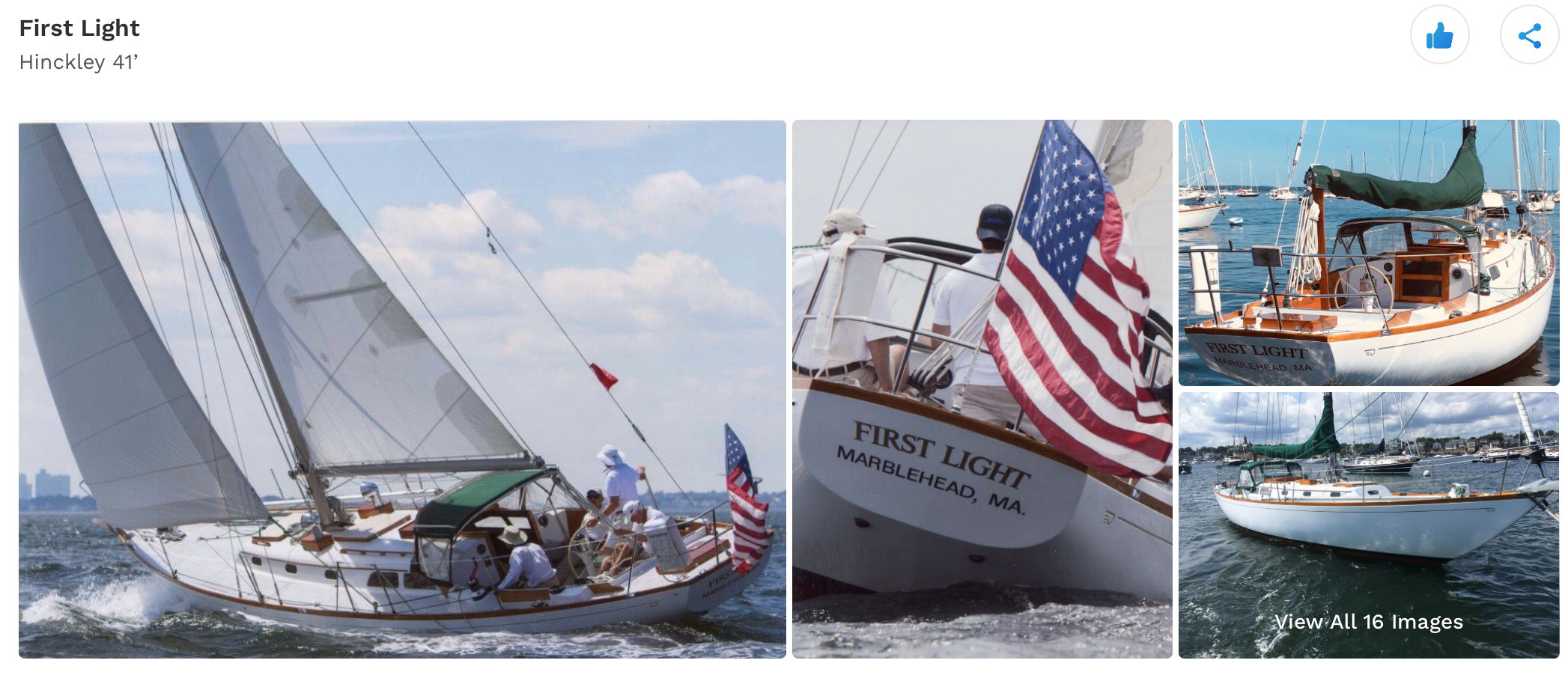
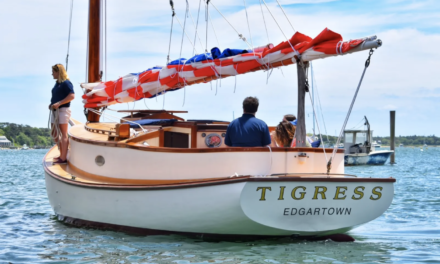
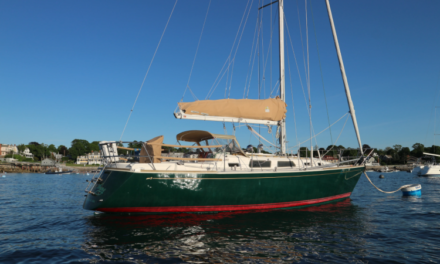
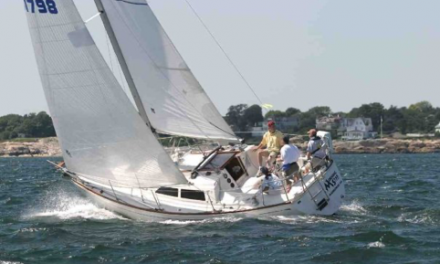
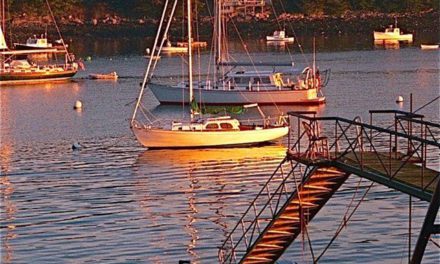
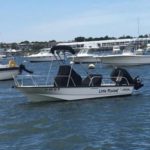

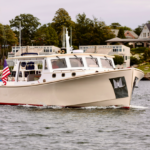
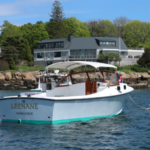
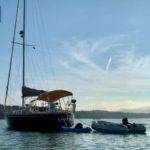
Beautiful boat! Good story, thanks!